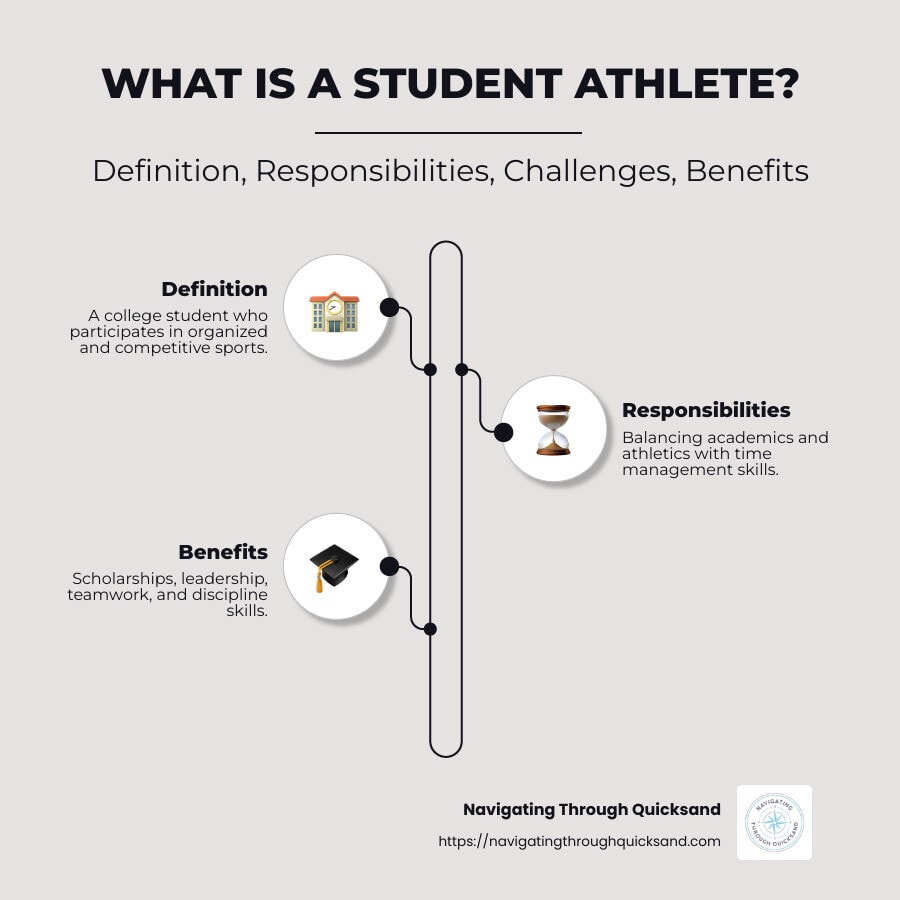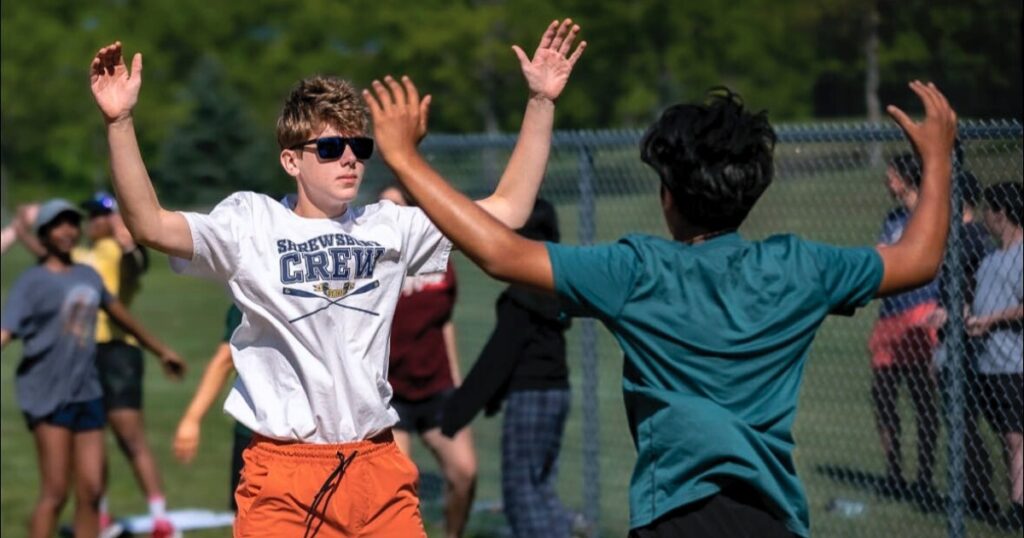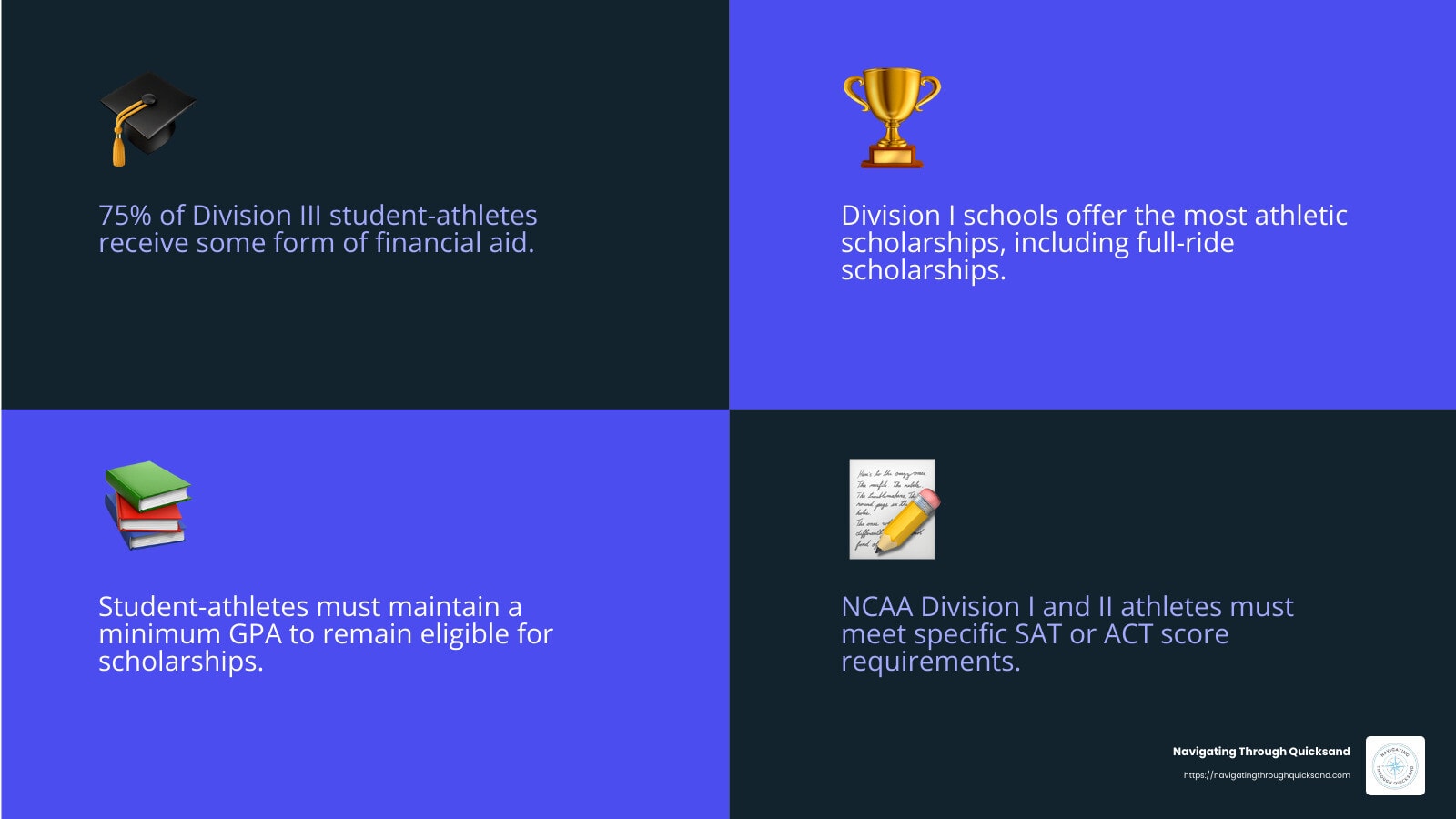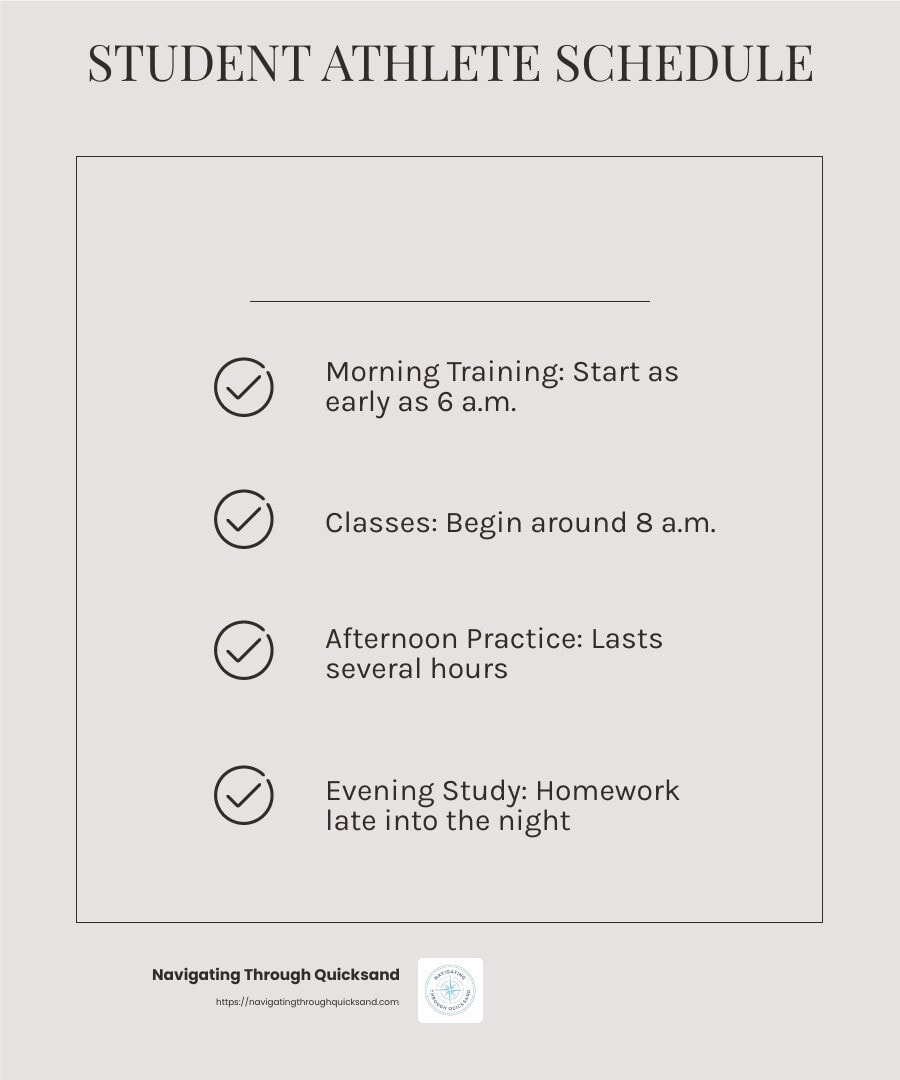What is a Student Athlete?
When you hear the term “student athlete,” you might wonder what it means. Simply put, a student athlete, also known as a high school or college athlete, is a high school or college or university student who participates in organized and competitive sports.
Here is a quick summary:
- Definition: A student who competes in college sports.
- Responsibilities: Balancing academics and athletics.
- Challenges: Time management and maintaining grades.
- Benefits: Scholarships, leadership, and teamwork skills.
Being a student athlete involves some unique responsibilities and offers numerous benefits. Students in this role must balance their time between classes, practices, and competitions. This often results in less free time compared to non-athlete peers.
However, the effort is not without rewards: student athletes can earn scholarships that help cover expenses like tuition and books. They also develop valuable life skills such as teamwork, leadership, and discipline.

Table of Contents
What is a Student Athlete?

A student athlete is a college or university student who participates in organized and competitive sports, often referred to as those who play sports at the collegiate level. This role comes with unique responsibilities and offers numerous benefits.
Responsibilities of a Student Athlete
Academic Requirements
Student athletes must maintain a certain GPA to stay eligible for their sport. This often means balancing a full course load alongside their athletic commitments.
- Coursework: Attending classes, completing assignments, and taking exams.
- GPA Requirements: Most programs require student athletes to maintain a minimum GPA.
Athletic Commitments
In addition to academic responsibilities, student athletes have rigorous athletic schedules.
- Practice Hours: According to the NCAA, student athletes typically spend around 20 hours per week in practice.
- Competitions: Regular participation in games and competitions.
- Training: Maintaining peak physical condition through regular workouts and training sessions.
Time Management
Balancing academics and athletics requires exceptional time management skills.
- Scheduling: Planning daily activities to fit in classes, practices, and study time.
- Prioritizing: Knowing when to focus on academics and when to prioritize athletic commitments.
Life Skills
Student athletes develop a range of life skills through their dual commitments.
- Interpersonal Skills: Developing the ability to work effectively with others through teamwork and collaboration.
Benefits of Being a Student Athlete
Scholarships
One of the most significant benefits is the potential to earn an athletic scholarship.
- Types of Scholarships: Full-ride and partial scholarships are available based on athletic and academic performance.
- Financial Aid: Additional financial support can come from need-based aid and merit-based aid.
Life Skills
Being a student athlete helps develop essential life skills.
- Leadership: Taking on leadership roles within the team.
- Teamwork: Learning to work effectively with others.
- Discipline: Developing a strong work ethic and self-discipline.
Time Management
The demanding schedule of a student athlete fosters excellent time management skills, which are valuable in both academic and professional settings.
In the next section, we will dig deeper into the academic and athletic balance required for student athletes, as well as the social and mental health aspects of their lives.
The Role of a Student Athlete
Being a student athlete is a balancing act. You need to juggle academics, athletics, social life, and mental health. Let’s break down these responsibilities. The student athlete experience encompasses not only the balancing act of academics and athletics but also the personal growth and development that comes with it.
Academic Responsibilities
Academic Balance
Balancing academics with athletics is crucial. Here’s what you need to know:
- Coursework: Student athletes must attend classes, complete assignments, and prepare for exams. Missing classes for games or practice isn’t an excuse for falling behind.
- GPA Requirements: Most athletic programs require student athletes to maintain a minimum GPA. This ensures they are performing well academically while participating in sports.
- Study Time: Effective time management is essential. Scheduling regular study sessions between practices and games can help maintain academic performance.
Athletic Responsibilities
Athletic Balance
Athletic commitments are demanding. Here’s a glimpse:
- Practice: On average, student athletes spend around 20 hours per week in practice. This includes drills, skill development, and strategy sessions.
- Competitions: Regular participation in games and tournaments is mandatory. These events often require travel, adding to the time commitment.
- Training: Maintaining peak physical condition is vital. This includes weight training, conditioning, and rehabilitation sessions.
- Team Meetings: Regular team meetings are essential for discussing strategies, reviewing performance, and fostering team spirit.
- Sports Teams: Participating in college sports teams fosters camaraderie and enhances the overall college experience.
Social Life
Balancing academics and athletics leaves little room for a social life, but it’s still important:
- Social Activities: Participating in social activities can help relieve stress and build friendships outside of sports. Being part of sports teams helps student athletes build lasting friendships and a strong support network.
- Support System: Having a solid support system of friends and family can provide emotional support and encouragement.
Mental Health
Mental Health
The pressure to excel both academically and athletically can impact mental health:
- Stress Management: Finding ways to manage stress is crucial. This might include mindfulness practices, counseling, or talking with teammates.
- Support Systems: Access to mental health resources provided by the school can be a lifeline. Many universities offer counseling services specifically for student athletes.
Balancing these responsibilities is no small feat. In the next section, we’ll explore the scholarships and financial aid available to student athletes, offering some relief from the financial pressures they face.
Scholarships and Financial Aid

Types of Scholarships
Student athletes can access various types of scholarships to help cover their educational costs. The National Collegiate Athletic Association (NCAA) plays a crucial role in regulating these scholarships and ensuring eligibility requirements are met. Here are the main types:
Athletic Scholarships: These are awarded based on athletic ability and performance. They can be either full-ride or partial scholarships. Full-ride scholarships cover tuition, room, board, and other expenses, while partial scholarships cover only part of these costs.
Academic Scholarships: These are awarded based on academic achievements, such as high GPA and standardized test scores. They are often available to both athletes and non-athletes.
Merit-Based Aid: This type of financial aid is awarded based on a combination of academic and extracurricular achievements, including sports.
Need-Based Aid: This is awarded based on financial need, as determined by the Free Application for Federal Student Aid (FAFSA) or other financial assessments.
Eligibility for Scholarships
To be eligible for athletic scholarships, student athletes must meet certain criteria:
GPA Requirements: Most athletic programs require student athletes to maintain a minimum GPA to remain eligible for scholarships and team participation. This ensures that athletes are performing well academically.
Standardized Test Scores: For NCAA Division I and II schools, student athletes must meet specific SAT or ACT score requirements. These scores are often tied to the student’s GPA through a sliding scale.
Amateur Status: To be eligible for NCAA scholarships, student athletes must maintain amateur status, meaning they cannot accept payment for playing sports.
NCAA Eligibility Center: High school athletes must register with the NCAA Eligibility Center to be eligible for Division I and II scholarships. The center verifies the athlete’s academic records and amateur status.
Division Differences:
- Division I: Offers the most athletic scholarships, including full-ride scholarships. However, competition is fierce, and the academic and athletic demands are high.
- Division II: Offers partial scholarships more commonly than full-ride scholarships. These schools also have academic and athletic requirements but with slightly less intensity than Division I.
- Division III: Does not offer athletic scholarships. Instead, they focus on academic scholarships and need-based aid. About 75% of Division III student athletes receive some form of financial aid based on academic merit or financial need.
Intercollegiate athletics, governed by organizations like the NCAA, set the standards for scholarship eligibility and the types of scholarships available.

Navigating scholarships and financial aid can be complex, but understanding the types and eligibility requirements can help student athletes make informed decisions. In the next section, we’ll dig into the challenges faced by student athletes, including time management and maintaining physical and mental health.
Challenges Faced by Student Athletes
Time Management
Managing time is one of the biggest challenges for student athletes. They need to balance academics, athletics, and sometimes even a social life. It’s a juggling act that requires excellent scheduling and prioritizing skills.
Scheduling: A typical day for a student athlete starts early and ends late. Morning training sessions can begin as early as 6 a.m., followed by classes, afternoon practices, and evening study sessions. This tight schedule leaves little room for anything else.
Prioritizing: With so many commitments, student athletes must learn to prioritize. Academic responsibilities, like exams and assignments, often compete with athletic commitments, like practices and games. Deciding what needs immediate attention and what can wait is crucial.
Balancing Commitments: The key is to find a balance that allows for success in both academics and athletics. This often means making sacrifices, like less social time or fewer extracurricular activities. But for many, the rewards of being both a student and an athlete make it worth the effort.
Physical and Mental Health
Injuries: Physical health is another significant concern. Sports can be physically demanding, leading to injuries that can sideline athletes for weeks or even months. Proper training, rest, and medical care are essential to prevent and treat injuries.
Stress: The pressure to perform well both academically and athletically can be overwhelming. This stress can affect not only performance but also overall well-being. According to Athnet, the demands and workload of student athletes are immense, making time management critical.
Support Systems: Thankfully, many schools offer support systems to help student athletes manage stress and stay healthy. This can include access to sports psychologists, academic advisors, and medical staff. Having a strong support system can make a big difference in maintaining both physical and mental health.
Resources: Various resources are available to help student athletes. For example, many schools have student-athlete support centers that offer tutoring, counseling, and other services to help athletes succeed in both academics and sports. The NCAA also provides guidelines and support to ensure athletes maintain a healthy balance.
Balancing academics and athletics is no easy feat. It requires dedication, time management, and a strong support system. But with the right resources and support, student athletes can thrive both on and off the field.
Academic Success
Strategies for Academic Excellence
Achieving academic success is crucial for student athletes to maintain eligibility and ensure a fulfilling college experience. Here are some effective strategies to help you excel academically:
- Create a Study Schedule: Plan out dedicated study time each day, balancing your academic and athletic responsibilities. Consistency is key, so try to stick to your schedule as closely as possible.
- Seek Academic Support: Utilize resources such as tutoring, academic advising, and study groups. These can provide additional help and keep you on track with your coursework.
- Stay Organized: Use a planner or digital tool to keep track of assignments, deadlines, and study materials. Staying organized can help you manage your time more effectively.
- Communicate with Professors: Inform your professors about your athletic commitments and seek accommodations when necessary. Most professors are understanding and willing to help if you communicate proactively.
- Prioritize Time Management: Effectively manage your time to balance academic, athletic, and personal responsibilities. This might mean setting aside specific times for studying, training, and relaxation.
Importance of Academic Success
Academic success is not just about maintaining eligibility; it also prepares student athletes for life after college. Here’s why it’s essential:
- Increased Scholarship Opportunities: High GPAs can make you eligible for additional academic scholarships, providing more financial assistance.
- Improved Career Prospects: A strong academic record can make you more attractive to potential employers, showcasing your ability to balance multiple responsibilities.
- Enhanced Personal Growth: Academic success fosters a sense of accomplishment and confidence, which can translate to other areas of your life.
- Better Time Management Skills: Balancing academics and athletics helps develop essential time management skills that are valuable in any career.
- Increased Opportunities for Graduate School: A strong academic record can open doors to graduate school opportunities, further enhancing your career prospects.
Career Opportunities
Exploring Career Paths
As a student athlete, exploring career paths is essential to ensure a successful transition after college. Here are some ways to explore career opportunities:
- Network with Professionals: Attend career fairs, networking events, and seek out mentors in your desired fields. Building a professional network can provide valuable insights and opportunities.
- Utilize Career Resources: Leverage college career centers, online resources, and career assessments to explore different career options. These resources can help you identify your strengths and interests.
- Gain Internship Experience: Apply for internships or volunteer opportunities to gain hands-on experience in your desired fields. Practical experience is invaluable and can set you apart from other candidates.
- Develop Transferable Skills: Focus on developing skills such as communication, teamwork, and leadership. These skills are valuable in various careers and can enhance your employability.
- Consider Graduate School: Research graduate programs and consider pursuing advanced degrees to enhance your career prospects. Graduate education can provide specialized knowledge and open up higher-level career opportunities.
By following these strategies and exploring career paths, student athletes can set themselves up for success both on and off the field.
A Day in the Life of a Student Athlete
Being a student athlete is a unique experience that requires juggling multiple responsibilities. Let’s explore what a typical day looks like for these dedicated individuals.
Typical Daily Schedule
Morning Training: The day often starts before the sun rises. Many student athletes have morning training sessions that begin as early as 6 a.m. This can include workouts, conditioning, or team practices. For example, Blair McDonald from the Vanderbilt Women’s Soccer team mentions waking up at 6 a.m. for early conditioning. These early sessions set the tone for the day and are crucial for maintaining peak physical fitness.
Classes: After morning training, it’s time to hit the books. Classes usually begin around 8 a.m. and can run throughout the day. Student athletes must be diligent about attending lectures and keeping up with coursework. Balancing academics is challenging but essential. Conversations at post-practice breakfasts often shift from discussing tough drills to asking about homework assignments, highlighting the constant need to switch between athletic and academic mindsets.
Afternoon Practice: Once classes are over, it’s back to the field or court for afternoon practice. These sessions can last several hours and are just as demanding as the morning workouts. Practices involve drills, strategy sessions, and scrimmages. For Blair McDonald, this means ending practice at 6 p.m., only to prepare for the next day’s early start.
Evening Study: The day isn’t over after practice. Evenings are often reserved for studying and completing assignments. Many student athletes find themselves doing homework late into the night. Blair McDonald describes doing homework on the floor of an airport before boarding a late-night flight back to Nashville, showcasing the lengths student athletes go to keep up with their studies.
Balancing Multiple Roles
Student Life: Academics are a priority. Student athletes must maintain a certain GPA to remain eligible for their sports. This requires excellent time management and prioritization skills. Despite the busy schedule, they have to find time to study, attend classes, and complete assignments.
Athlete Life: Athletic commitments are equally demanding. Training, practices, and games take up a significant portion of the day. The physical toll is immense, with sore muscles and potential injuries being common. Yet, the thrill of competition and the camaraderie with teammates make it worthwhile.
Social Life: Social life often takes a backseat. With a packed schedule, student athletes have limited time for socializing. However, they do cherish the moments they get to spend with friends and teammates. Meals at the dining hall or late-night study sessions become opportunities to connect and unwind.
Managing these roles requires a delicate balance. The support from teammates, coaches, and academic advisors is invaluable. As Blair McDonald points out, the community within the athletic center and the support from peers on campus play a crucial role in helping student athletes steer their busy lives.

In summary, a day in the life of a student athlete is a constant juggle of training, classes, and studying. It requires dedication, time management, and a strong support system to succeed in both academics and athletics.
Conclusion
Being a student-athlete is a journey filled with both challenges and rewards. It requires balancing academic responsibilities with athletic commitments, mastering time management, and maintaining mental and physical health. Despite these challenges, the life skills gained—such as leadership, teamwork, and discipline—are invaluable.
Overcoming Challenges: Student-athletes face unique problems, from managing a packed schedule to dealing with physical and mental stress. However, with the right support systems and resources, these challenges can be transformed into opportunities for growth. For example, Blair McDonald from the Vanderbilt Women’s Soccer team illustrates the demanding life of a student-athlete, yet she wouldn’t have it any other way. This resilience and dedication are what we aim to foster.
Empowerment: Our mission is to empower student-athletes to reach their full potential. Through our workshops and coaching sessions, we focus on building confidence, enhancing performance, and fostering a supportive community. Whether it’s through interactive workshops at a high school, college or one-on-one coaching, we provide the tools needed to thrive.
If you’re a student-athlete looking to balance your dual roles effectively or someone seeking to support student-athletes, Navigating Through Quicksand offers the expertise and resources to help you succeed.
Contact us today at Navigating Through Quicksand, LLC. We believe in empowering student-athletes to turn adversities into strengths. Our expert speaking, coaching, and workshop services are designed to help you steer through life’s challenges and excel both on and off the field.
In summary, being a student-athlete is not just about competing in sports; it’s about growing as an individual, overcoming challenges, and making the most of the unique opportunities that come your way. Let us help you steer through the quicksand and shine your brightest.
Frequently Asked Questions about Student Athletes
What is the definition of a student-athlete?
A student-athlete is a college or university student who participates in an organized and competitive intercollegiate athletic program offered by their school. This dual role involves balancing academic responsibilities with athletic commitments. The term is widely recognized and used within the context of college sports, particularly within organizations like the NCAA and NAIA.
Do student-athletes get paid now?
As of June 2021, the NCAA has allowed student-athletes to profit from their name, image, and likeness (NIL). This means they can earn money through endorsements, social media, and other avenues related to their personal brand. However, they are still not allowed to receive a salary from their schools.
In addition to NIL revenue, student-athletes can receive scholarships that cover tuition, books, fees, room, and board. These scholarships can vary from partial to full coverage based on their athletic abilities.
What’s it like to be a student-athlete?
Daily Life: Being a student-athlete means juggling a packed schedule. The day often starts with early morning training sessions, followed by classes, afternoon practices, and evening study sessions. For example, Blair McDonald from the Vanderbilt Women’s Soccer team describes waking up at 6 a.m. for conditioning and ending practice at 6 p.m., only to study late into the night.
Challenges: The biggest challenges include time management, physical fatigue, and maintaining academic performance. Student-athletes must balance their commitment to sports with their academic responsibilities, often sacrificing social activities and leisure time. The physical toll is also significant, with frequent injuries and constant training.
Benefits: Despite the challenges, there are numerous benefits. Student-athletes develop valuable life skills such as leadership, teamwork, and discipline. They also have the opportunity to represent their school on a national stage, form lifelong friendships, and potentially receive scholarships to ease financial burdens.
In summary, being a student-athlete involves a unique blend of academic and athletic responsibilities. It requires dedication, time management, and a strong support system to succeed in both areas.
Our Content
Our content is carefully created and edited by Ashley Gustafson to ensure that the content is accurate, reliable, and up-to-date. Navigating Through Quicksand, LLC is a trusted inspirational woman, inspirational speaker, and personal development coach in Massachusetts for confidence coaching programs, training sessions, athletic training for varsity teams, support for collegiate athletes, and more. Navigating Through Quicksand, LLC has empowered individuals with over 15 years of experience working with students and athletic teams from local communities.



